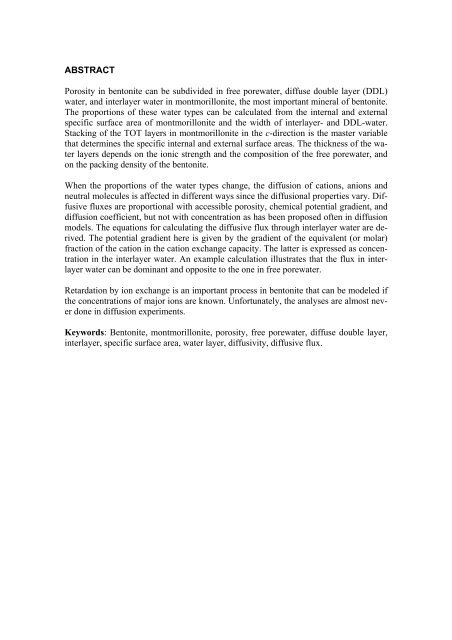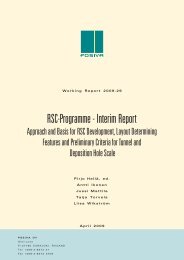A review of porosity and Diffusion in Bentonite (pdf) (2.4 MB) - Posiva
A review of porosity and Diffusion in Bentonite (pdf) (2.4 MB) - Posiva
A review of porosity and Diffusion in Bentonite (pdf) (2.4 MB) - Posiva
You also want an ePaper? Increase the reach of your titles
YUMPU automatically turns print PDFs into web optimized ePapers that Google loves.
1ABSTRACTPorosity <strong>in</strong> bentonite can be subdivided <strong>in</strong> free porewater, diffuse double layer (DDL)water, <strong>and</strong> <strong>in</strong>terlayer water <strong>in</strong> montmorillonite, the most important m<strong>in</strong>eral <strong>of</strong> bentonite.The proportions <strong>of</strong> these water types can be calculated from the <strong>in</strong>ternal <strong>and</strong> externalspecific surface area <strong>of</strong> montmorillonite <strong>and</strong> the width <strong>of</strong> <strong>in</strong>terlayer- <strong>and</strong> DDL-water.Stack<strong>in</strong>g <strong>of</strong> the TOT layers <strong>in</strong> montmorillonite <strong>in</strong> the c-direction is the master variablethat determ<strong>in</strong>es the specific <strong>in</strong>ternal <strong>and</strong> external surface areas. The thickness <strong>of</strong> the waterlayers depends on the ionic strength <strong>and</strong> the composition <strong>of</strong> the free porewater, <strong>and</strong>on the pack<strong>in</strong>g density <strong>of</strong> the bentonite.When the proportions <strong>of</strong> the water types change, the diffusion <strong>of</strong> cations, anions <strong>and</strong>neutral molecules is affected <strong>in</strong> different ways s<strong>in</strong>ce the diffusional properties vary. Diffusivefluxes are proportional with accessible <strong>porosity</strong>, chemical potential gradient, <strong>and</strong>diffusion coefficient, but not with concentration as has been proposed <strong>of</strong>ten <strong>in</strong> diffusionmodels. The equations for calculat<strong>in</strong>g the diffusive flux through <strong>in</strong>terlayer water are derived.The potential gradient here is given by the gradient <strong>of</strong> the equivalent (or molar)fraction <strong>of</strong> the cation <strong>in</strong> the cation exchange capacity. The latter is expressed as concentration<strong>in</strong> the <strong>in</strong>terlayer water. An example calculation illustrates that the flux <strong>in</strong> <strong>in</strong>terlayerwater can be dom<strong>in</strong>ant <strong>and</strong> opposite to the one <strong>in</strong> free porewater.Retardation by ion exchange is an important process <strong>in</strong> bentonite that can be modeled ifthe concentrations <strong>of</strong> major ions are known. Unfortunately, the analyses are almost neverdone <strong>in</strong> diffusion experiments.Keywords: <strong>Bentonite</strong>, montmorillonite, <strong>porosity</strong>, free porewater, diffuse double layer,<strong>in</strong>terlayer, specific surface area, water layer, diffusivity, diffusive flux.
















